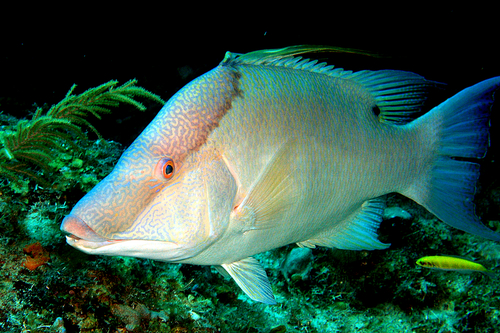
Hogfish
The Atlantic bluefin tuna (Thunnus thynnus) is a highly migratory, large pelagic fish renowned for its size, speed, and commercial value. It plays a crucial role in the marine ecosystem and has significant cultural and economic importance, particularly in the sushi industry.
12 23 years
Lifespan
91 cm
Length
Vulnerable
Conservation Status
18 km/h
Swimming speed
Carnivorous
Diet
Local Migration
Migration
Appearance Overview
The Atlantic bluefin tuna is a large, streamlined fish with a metallic blue body and a silvery-white belly.
Color
Dark metallic blue on top, silvery-white underside
Body shape
Torpedo-shaped, built for speed and endurance
Fins
Two dorsal fins, the first depressible; small finlets run from dorsal and anal fins to the tail
Length
Up to 13 feet (4 meters)
Weight
Up to 2,000 lbs (907 kg)
Diet
Carnivorous, feeding on fish, squid, crustaceans, and eels.
Feeding Behavior
Highly opportunistic predators, they use their speed and agility to hunt. They can hunt cooperatively, herding prey.
Social Behavior
Forms large schools, often segregated by size; highly migratory.
Commercial Relevance
Extremely high value, especially in sushi and sashimi markets, where a single fish can fetch hundreds of thousands of dollars.
Conservation measures
International fishing quotas, size limits, and seasonal closures; ongoing efforts to improve stock management and reduce illegal fishing.
Status
Endangered (Varies by stock; Western Atlantic stock is Endangered, Eastern Atlantic/Mediterranean stock is Near Threatened).
Threats
Overfishing, primarily due to high demand for sushi; bycatch in fisheries targeting other species; climate change affecting prey distribution.
Habitat Distribution
Depth Range
0-3,300 feet (0-1,000 meters), but commonly found in shallower waters.
Geographic Range
Atlantic Ocean, Mediterranean Sea, and formerly the Black Sea.
Preferred Environment
Temperate and subtropical waters; highly migratory, following warm currents.
Reproduction and Life Cycle
Breeding Habits
Spawns in warm waters; two main spawning grounds: the Mediterranean Sea (Eastern stock) and the Gulf of Mexico (Western stock).
Development Stages
Eggs hatch into larvae; rapid growth in the first year; juveniles mature into adults.
Fecundity
Females can release up to 30 million eggs per spawning season.
Maturity Age
Western Atlantic stock: 8-12 years; Eastern Atlantic stock: 4-5 years.
Faqs about Hogfish
How long do Atlantic bluefin tuna live?
Atlantic bluefin tuna can live up to 40 years.
Are bluefin tuna fast swimmers?
Yes, they are among the fastest fish in the ocean, capable of bursts of speed over 40 mph.
Where are Atlantic bluefin tuna found?
They are primarily found in the Atlantic Ocean, but their migration patterns can take them across vast distances.
How deep can bluefin tuna dive?
They can dive to depths of over 3,000 feet (900 meters).
Is there a difference between Western and Eastern Atlantic bluefin tuna?
The Western Atlantic stock is generally smaller, reaching maturity earlier and having a shorter lifespan than the Eastern Atlantic stock.
How do bluefin tuna stay warm in cold water?
They have specialized blood vessels that allow them to maintain a body temperature higher than the surrounding water, aiding in muscle efficiency.
How can consumers help protect bluefin tuna?
Look for sustainable seafood certifications and avoid consuming bluefin tuna unless its origin is verified as sustainable.
How do bluefin tuna reproduce?
Females release millions of eggs into the water, which are then fertilized externally by males.
Copyright @ Nature Style Limited. All Rights Reserved.
 English
English